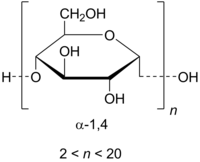
Photo from wikipedia
In-depth molecular structure and properties of cassava-derived resistant maltodextrins (RMDs) were determined. Cassava starch was dextrinized with 0.04% or 0.06% HCl at 120 °C for 60-180 min to obtain resistant dextrins (RDs),… Click to show full abstract
In-depth molecular structure and properties of cassava-derived resistant maltodextrins (RMDs) were determined. Cassava starch was dextrinized with 0.04% or 0.06% HCl at 120 °C for 60-180 min to obtain resistant dextrins (RDs), which were further hydrolyzed by α-amylase to produce RMDs. Prolonging dextrinization duration decreased proportion of α-1,4 linkages and α-/β-reducing ends but increased fraction of indigestible α-/β-1,6, β-1,4, β-1,2 linkages, degree of branching (DB), degree of polymerization, relative molecular weight, and total dietary fiber (TDF) content of the RMDs. Moreover, RMDs had greater proportion of β-glycosidic linkages, α-/β-reducing end, DB, TDF, and low molecular weight dietary fiber (LMWDF) content than their RD counterparts. Potential prebiotic activity score was higher in RMDs with abundant LMWDF fraction but low DB. Slight difference in the glass transition temperature of maximally freeze-concentrated unfrozen phase (Tg') and unfrozen water content was found among RMDs. However, RMDs had lower Tg' than their RD counterparts.
Journal Title: Food chemistry
Year Published: 2021
Link to full text (if available)
Share on Social Media: Sign Up to like & get
recommendations!